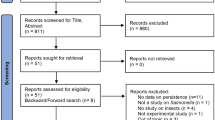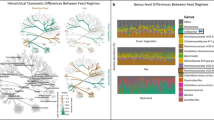Abstract
A healthy gut microbiome is critical for nutrient metabolism, pathogen inhibition and immune regulation, and is highly influenced by diet. Edible insects are good sources of protein and micronutrients, but unlike other animal-derived foods, they also contain both dietary fibre and omega-3 fatty acids that can modulate gut microbiota. Here we explore the potential impacts of insect consumption on the microbiome. Laboratory, animal and human studies indicate that insect fibre in the form of chitin and its derivatives can modify gut microbiota with beneficial outcomes. Some insects also contain favourable omega-3/omega-6 ratios. We identify gaps in the literature—especially a dearth of human studies—that must be addressed to better understand health impacts of entomophagy. Insects, already eaten across the globe, can be farmed using fewer resources than conventional livestock. Widening the research scope offers an opportunity to advance use of edible insects to address interconnected environmental and health challenges.
This is a preview of subscription content, access via your institution
Access options
Access Nature and 54 other Nature Portfolio journals
Get Nature+, our best-value online-access subscription
$29.99 / 30 days
cancel any time
Subscribe to this journal
Receive 12 digital issues and online access to articles
$119.00 per year
only $9.92 per issue
Buy this article
- Purchase on Springer Link
- Instant access to full article PDF
Prices may be subject to local taxes which are calculated during checkout
Similar content being viewed by others
References
van Huis, A. et al. Edible Insects: Future Prospects for Food and Feed Security (FAO, 2013); https://www.fao.org/3/i3253e/i3253e.pdf
Ramos-Elorduy, J. Anthropo-entomophagy: cultures, evolution and sustainability. Entomol. Res. 39, 271–288 (2009).
Jongema, Y. List of Edible Insects of the World (April 1, 2017) (WUR, 2017); http://www.wageningenur.nl/en/Expertise-Services/Chair-groups/Plant-Sciences/Laboratory-of-Entomology/Edible-insects/Worldwide-species-list.htm
Oonincx, D. G. A. B. et al. An exploration on greenhouse gas and ammonia production by insect species suitable for animal or human consumption. PLoS ONE 5, e14445 (2010).
Meyer-Rochow, V. B., Gahukar, R. T., Ghosh, S. & Jung, C. Chemical composition, nutrient quality and acceptability of edible insects are affected by species, developmental stage, gender, diet, and processing method. Foods 10, 1036 (2021).
Belluco, S. et al. Edible insects: a food security solution or a food safety concern? Anim. Front. 5, 25–30 (2015).
Finke, M. D. Complete nutrient content of four species of feeder insects. Zoo Biol. 32, 27–36 (2013).
Finke, M. D. & Oonincx, D. G. A. B. in Insects as Food and Feed: From Production to Consumption (eds van Huis, A. & Tomberlin, J. K.) 291–316 (Wageningen Academic, 2017).
Mwangi, M. N. et al. Insects as sources of iron and zinc in human nutrition. Nutr. Res. Rev. https://doi.org/10.1017/S0954422418000094 (2018)
Roos, N. & van Huis, A. Consuming insects: are there health benefits? J. Insects Food Feed 3, 225–229 (2017).
Finke, M. D. Estimate of chitin in raw whole insects. Zoo Biol. 26, 105–115 (2007).
Rumpold, B. A. & Schlüter, O. K. Nutritional composition and safety aspects of edible insects. Mol. Nutr. Food Res. 57, 802–823 (2013).
FoodData Central (USDA, 2019); https://fdc.nal.usda.gov/fdc-app.html#/food-details/168580/nutrients
Mack, I. et al. The role of chitin, chitinases, and chitinase-like proteins in pediatric lung diseases. Mol. Cell. Pediatr. 2, 3 (2015).
Paoletti, M. G., Norberto, L., Damini, R. & Musumeci, S. Human gastric juice contains chitinase that can degrade chitin. Ann. Nutr. Metab. 51, 244–251 (2007).
Janiak, M. C., Chaney, M. E. & Tosi, A. J. Evolution of acidic mammalian chitinase genes (CHIA) is related to body mass and insectivory in primates. Mol. Biol. Evol. https://doi.org/10.1093/molbev/msx312 (2017).
Tabata, E. et al. Chitin digestibility is dependent on feeding behaviors, which determine acidic chitinase mRNA levels in mammalian and poultry stomachs. Sci. Rep. 8, 1461 (2018).
Kumar, M. N. V. R. A review of chitin and chitosan applications. React. Funct. Polym. 46, 1–27 (2000).
Ibitoye, E. B. et al. Extraction and physicochemical characterization of chitin and chitosan isolated from house cricket. Biomed. Mater. 13, 025009 (2018).
Marei, N. H., El-Samie, E. A., Salah, T., Saad, G. R. & Elwahy, A. H. M. Isolation and characterization of chitosan from different local insects in Egypt. Int. J. Biol. Macromol. 82, 871–877 (2016).
Mohan, K. et al. Recent insights into the extraction, characterization, and bioactivities of chitin and chitosan from insects. Trends Food Sci. Technol. 105, 17–42 (2020).
Alessandri, G. et al. Ability of bifidobacteria to metabolize chitin–glucan and its impact on the gut microbiota. Sci Rep. 9, 5755 (2019).
Rodriguez, J. et al. Metabolite profiling reveals the interaction of chitin–glucan with the gut microbiota. Gut Microbes 12, 1810530 (2020).
Khoushab, F. & Yamabhai, M. Chitin research revisited. Mar. Drugs 8, 1988–2012 (2010).
Prajapati, B., Rajput, P., Kumar Jena, P. & Seshadri, S. Investigation of chitosan for prevention of diabetic progression through gut microbiota alteration in sugar rich diet induced diabetic rats. Curr. Pharm. Biotechnol. 17, 173–184 (2016).
Wu, X., Kim, M. J., Yang, H. J. & Park, S. Chitosan alleviated menopausal symptoms and modulated the gut microbiota in estrogen-deficient rats. Eur. J. Nutr. 60, 1907–1919 (2021).
Zheng, J. et al. Chitosan oligosaccharides improve the disturbance in glucose metabolism and reverse the dysbiosis of gut microbiota in diabetic mice. Carbohydr. Polym. 190, 77–86 (2018).
Kong, X. F. et al. Dietary supplementation with chitooligosaccharides alters gut microbiota and modifies intestinal luminal metabolites in weaned Huanjiang mini-piglets. Livest. Sci. 160, 97–101 (2014).
Young, W. et al. Feeding bugs to bugs: edible insects modify the human gut microbiome in an in vitro fermentation model. Front. Microbiol. 11, 1763 (2020).
de Carvalho, N. M., Teixeira, F., Silva, S., Madureira, A. R. & Pintado, M. E. Potential prebiotic activity of Tenebrio molitor insect flour using an optimized in vitro gut microbiota model. Food Funct. 10, 3909–3922 (2019).
Stull, V. J. et al. Impact of edible cricket consumption on gut microbiota in healthy adults, a double-blind, randomized crossover trial. Sci. Rep. 8, 10762 (2018).
Kipkoech, C., Kinyuru, J. N., Imathiu, S., Meyer-Rochow, V. B. & Roos, N. In vitro study of cricket chitosan’s potential as a prebiotic and a promoter of probiotic microorganisms to control pathogenic bacteria in the human gut. Foods 10, 2310 (2021).
Jeon, Y.-J., Park, P.-J. & Kim, S.-K. Antimicrobial effect of chitooligosaccharides produced by bioreactor. Carbohydr. Polym. 44, 71–76 (2001).
Gil, G., Mónaco, S., Cerrutti, P. & Galvagno, M. Selective antimicrobial activity of chitosan on beer spoilage bacteria and brewing yeasts. Biotechnol. Lett. 26, 569–574 (2004).
Chien, R.-C., Yen, M.-T. & Mau, J.-L. Antimicrobial and antitumor activities of chitosan from shiitake stipes, compared to commercial chitosan from crab shells. Carbohydr. Polym. 138, 259–264 (2016).
Fernandes, J. C. et al. Antimicrobial effects of chitosans and chitooligosaccharides, upon Staphylococcus aureus and Escherichia coli, in food model systems. Food Microbiol. 25, 922–928 (2008).
Selenius, O., Korpela, J., Salminen, S. & Gallego, C. G. Effect of chitin and chitooligosaccharide on in vitro growth of Lactobacillus rhamnosus GG and Escherichia coli TG. Appl. Food Biotechnol. 5, 163–172 (2018).
Lopez-Santamarina, A. et al. Animal-origin prebiotics based on chitin: an alternative for the future? A critical review. Foods 9, 782 (2020).
Mateos-Aparicio, I., Mengíbar, M. & Heras, A. Effect of chito-oligosaccharides over human faecal microbiota during fermentation in batch cultures. Carbohydr. Polym. 137, 617–624 (2016).
Li, J. & Zhuang, S. Antibacterial activity of chitosan and its derivatives and their interaction mechanism with bacteria: current state and perspectives. Eur. Polym. J. 138, 109984 (2020).
Costantini, L., Molinari, R., Farinon, B. & Merendino, N. Impact of omega-3 fatty acids on the gut microbiota. Int. J. Mol. Sci. 18, 2645 (2017).
Watson, H. et al. A randomised trial of the effect of omega-3 polyunsaturated fatty acid supplements on the human intestinal microbiota. Gut 67, 1974–1983 (2018).
Robertson, R. C. et al. Omega-3 polyunsaturated fatty acids critically regulate behaviour and gut microbiota development in adolescence and adulthood. Brain Behav. Immun. 59, 21–37 (2017).
Paul, A. et al. Insect fatty acids: a comparison of lipids from three orthopterans and Tenebrio molitor L. larvae. J. Asia-Pac. Entomol. 20, 337–340 (2017).
Yang, L.-F., Siriamornpun, S. & Li, D. Polyunsaturated fatty acid content of edible insects in Thailand. J. Food Lipids 13, 277–285 (2006).
Paul, A. et al. Nutritional composition and rearing potential of the meadow grasshopper (Chorthippus parallelus Zetterstedt). J. Asia Pac. Entomol. 19, 1111–1116 (2016).
Wathne, A. M., Devle, H., Naess-Andresen, C. F. & Ekeberg, D. Identification and quantification of fatty acids in T. viridissima, C. biguttulus, and C. brunneus by GC–MS. J. Lipids 2018, 3679247 (2018).
Oonincx, D. G. A. B., Laurent, S., Veenenbos, M. E. & van Loon, J. J. A. Dietary enrichment of edible insects with omega 3 fatty acids. Insect Sci. https://doi.org/10.1111/1744-7917.12669 (2019).
Gentile, C. L. & Weir, T. L. The gut microbiota at the intersection of diet and human health. Science 362, 776–780 (2018).
Smith, M. R., Stull, V. J., Patz, J. A. & Myers, S. S. Nutritional and environmental benefits of increasing insect consumption in Africa and Asia. Environ. Res. Lett. 16, 065001 (2021).
Harti, A. S., Haryati, D. S., Sunarto, Setyaningsih, W. & Yatmihatun, S. The potential chito-oligosaccharide (COS) as natural prebiotic and preservatives on synbiotic tofu in Indonesia. Int. J. Pharma Med. Biol. Sci. 4, 204–208 (2015).
Author information
Authors and Affiliations
Corresponding author
Ethics declarations
Competing interests
The authors declare no competing interests.
Peer review
Peer review information
Nature Food thanks Matthew Moore and the other, anonymous, reviewer(s) for their contribution to the peer review of this work.
Additional information
Publisher’s note Springer Nature remains neutral with regard to jurisdictional claims in published maps and institutional affiliations.
Rights and permissions
Springer Nature or its licensor (e.g. a society or other partner) holds exclusive rights to this article under a publishing agreement with the author(s) or other rightsholder(s); author self-archiving of the accepted manuscript version of this article is solely governed by the terms of such publishing agreement and applicable law.
About this article
Cite this article
Stull, V.J., Weir, T.L. Chitin and omega-3 fatty acids in edible insects have underexplored benefits for the gut microbiome and human health. Nat Food 4, 283–287 (2023). https://doi.org/10.1038/s43016-023-00728-7
Received:
Accepted:
Published:
Issue Date:
DOI: https://doi.org/10.1038/s43016-023-00728-7



